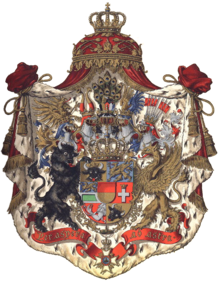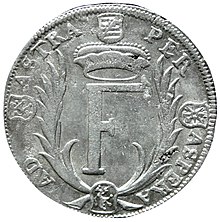Per aspera ad astra
Per aspera ad astra, literally "through the rough to the stars," is a Latin phrase; it means "through rough paths one reaches the stars" or "through hardship one reaches the stars."
This expression has its origin in Seneca. It comes from his tragedy Hercules furens (Hercules gone wild). There it says: "Non est ad astra mollis e terris via", German "Es ist kein weicher (= comfortable) Weg von der Erde zu den Sternen".
Heinrich von Kleist mentions in his drama Prinz Friedrich von Homburg oder die Schlacht bei Fehrbellin (Prince Frederick of Homburg or the Battle of Fehrbellin) this saying on the standard of the Swedish army, which was captured by Frederick II of Hesse-Homburg at the Battle of Fehrbellin on 28 June 1675.
The phrase is found on the coat of arms and the Order of the Wendish Crown of Mecklenburg-Schwerin, on the Latvian Three Star Order, and is the motto of the United States Air Force Academy, among others. Per ardua ad astra' - "Through misery to the stars" - is related in meaning and is used, for example, by the Royal Air Force, as well as by the Royal Australian Air Force and the Royal New Zealand Air Force.
In addition, the saying can be found on the flag of the US state of Kansas and under the coat of arms of the city of Gouda. The creators of the television series Star Trek borrowed the motto as the motto of Starfleet. In addition, the Göttingen fraternity Brunsviga, the Hallenser Landsmannschaft Vitebergia, the Nuremberg fraternity Pythagoras, the Brunswick fraternity Alemannia, the Brunswick fraternity Germania, the T.W.V. Teutonia zu Rosenheim, the K. D.St.V. Burgundia-Leipzig zu Düsseldorf in the CV, and the Catholic-Austrian student fraternity K.ö.St.V. Almgau Salzburg in the MKV, as well as the K.a.V. Danubia Wien-Korneuburg in the ÖCV use the phrase as their motto or motto. Also the University of Klagenfurt, the California State University, East Bay and the Transnistrian Taras Shevchenko University use the phrase as their motto.
Per aspera ad astra is also the motto of the Prussian noble family von Wernsdorff.
In addition, the phrase is found in the modified form "Ad Astra Per Aspera" on the plaque commemorating the burned crew of Apollo 1 at the launch pad at Cape Canaveral.

Per aspera ad astra on the coat of arms of Mecklenburg-Schwerin

Per aspera ad astra on the silver coin 2/3 thaler (guilder) 1679 of Frederick I, Duke of Saxe-Gotha and Altenburg (1675-1691)
Works
A selection of works entitled Per aspera ad astra:
- March by Ernst Urbach
- Book titles by Ernst Legal
- Frieze in 34 panels by Karl Wilhelm Diefenbach
- Music album from Stars of the Lid
Questions and Answers
Q: What does the phrase "Per aspera ad astra" mean?
A: The phrase means "through hardships to the stars".
Q: Is "Per aspera ad astra" a common Latin phrase?
A: Yes, it is a popular Latin phrase.
Q: What is the meaning of "ad astra"?
A: "Ad astra" means "to the stars".
Q: How is the phrase "Per aspera ad astra" usually written?
A: The phrase is usually written "Per aspera ad astra".
Q: Can "ad astra" be used in other Latin phrases?
A: Yes, "ad astra" can be used in other Latin phrases.
Q: Does "Per aspera ad astra" suggest an easy path to success?
A: No, it suggests that success can only be achieved through hardships.
Q: What does the phrase "Per aspera ad astra" imply?
A: The phrase implies that to reach the stars (success), we must face and overcome difficult challenges.
Search within the encyclopedia